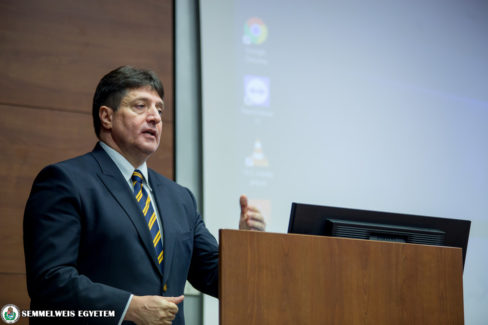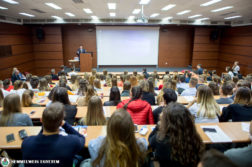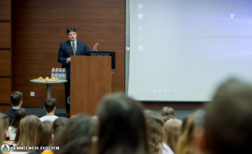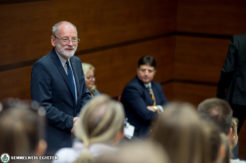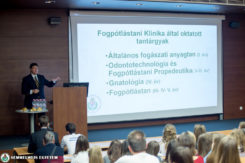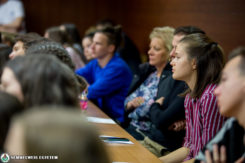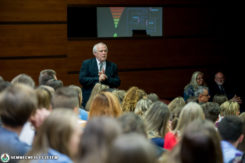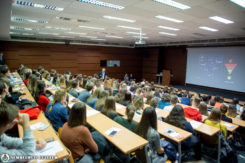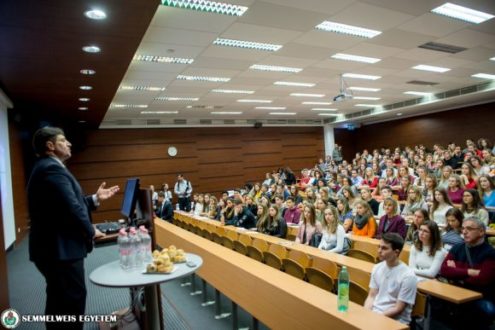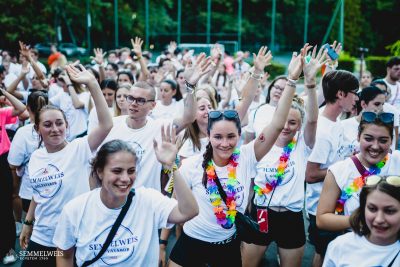The Faculty of Dentistry’s centre was full of prospective university students and their parents on the faculty’s Open Day. The presentation on Friday covered information about the dental training system, the faculty’s education system, the requirements for obtaining a diploma and later career opportunities. The high school students were able to partake in an institute visit at the closing of the Open Day, where they could get a look into the work conducted by the various labs.
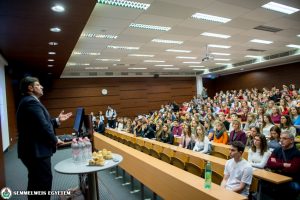 On the Open Day, Dr. Péter Hermann, Vice Rector of Educational Affairs and the Director of the Department of Prosthodontics, greeted the audience. He pointed out that the Semmelweis Faculty of Dentistry was considered the top program choice for 300-350 applicants on average, and according to the application results of the previous years, Semmelweis University results were 15-20 points higher than those of competing programs. He also mentioned that the University has been ranked as the best Hungarian institution in different international rankings year after year. He pointed out to students that dental students – under the supervision of trainers – can participate in patient care as early as their third year, and by the end of their training they have full competency to work full-time.
On the Open Day, Dr. Péter Hermann, Vice Rector of Educational Affairs and the Director of the Department of Prosthodontics, greeted the audience. He pointed out that the Semmelweis Faculty of Dentistry was considered the top program choice for 300-350 applicants on average, and according to the application results of the previous years, Semmelweis University results were 15-20 points higher than those of competing programs. He also mentioned that the University has been ranked as the best Hungarian institution in different international rankings year after year. He pointed out to students that dental students – under the supervision of trainers – can participate in patient care as early as their third year, and by the end of their training they have full competency to work full-time.
In his lecture after his greeting speech, he presented on the Department of Prosthodontics, outlining the course material covered in each grade. Dr. Péter Hermann talked about the rapid development of the materials used for prosthodontics. He also talked about the fact that in the last 10 to 20 years, implantology has essentially disrupted the field of dentistry and has become a daily part of it. He also spoke of rapidly expanding digital technologies, highlighting that computer imaging is nowadays a part of everyday dentistry as well. He also mentioned one of the specialties of the faculty’s Education Centre, the dental chairs designed for left-handed people. At the end of his presentation, he emphasized to the students to choose their specialty and studies with care, and wished the high school seniors every success for graduation.
 Dr. Károly Bartha, Vice Dean, after the short presentation of the university, pointed out that one third of the university’s 10,675 students come from abroad, from 74 countries of the world to complete their studies. He highlighted: Semmelweis University plays an important role in training healthcare professionals: 70 percent of all dentists in Hungary, half of the pharmacists, and 42 percent of general practitioners earn their diploma from Semmelweis. In describing the faculty statistics, he said that nearly 900 students are enrolled in the Hungarian language program, and 400 foreign students study in the English and German language programs. He reviewed the history of the faculty, recalling that the Education Centre opened 11 years ago, and proceeded to introduce the Faculty of Dentistry’s various educational units. He spoke about resident training, mentioning that the residents serve an important role in the education program. He talked about the importance of preventive dentistry, recalling that tooth decay and gingivitis are common diseases in Hungary. His presentation also touched upon fillings, fluoride-containing toothpastes, cavities, and root canal treatment. In his closing remarks, he advised those present to think ahead, and objectively assess their ambitions for pursuing higher education: are they ready to put a great deal of time and energy into their studies, do they have the proper manual skills, can they deal with and treat other people’s problems – a dentist must be empathetic – he said. Finally, he shared with the seniors his wish for them to find a vocation in which they find constant fulfillment.
Dr. Károly Bartha, Vice Dean, after the short presentation of the university, pointed out that one third of the university’s 10,675 students come from abroad, from 74 countries of the world to complete their studies. He highlighted: Semmelweis University plays an important role in training healthcare professionals: 70 percent of all dentists in Hungary, half of the pharmacists, and 42 percent of general practitioners earn their diploma from Semmelweis. In describing the faculty statistics, he said that nearly 900 students are enrolled in the Hungarian language program, and 400 foreign students study in the English and German language programs. He reviewed the history of the faculty, recalling that the Education Centre opened 11 years ago, and proceeded to introduce the Faculty of Dentistry’s various educational units. He spoke about resident training, mentioning that the residents serve an important role in the education program. He talked about the importance of preventive dentistry, recalling that tooth decay and gingivitis are common diseases in Hungary. His presentation also touched upon fillings, fluoride-containing toothpastes, cavities, and root canal treatment. In his closing remarks, he advised those present to think ahead, and objectively assess their ambitions for pursuing higher education: are they ready to put a great deal of time and energy into their studies, do they have the proper manual skills, can they deal with and treat other people’s problems – a dentist must be empathetic – he said. Finally, he shared with the seniors his wish for them to find a vocation in which they find constant fulfillment.
During the rest of the day, visitors could listen to lectures on oral diagnostics, oral surgery, pediatric dentistry and orthodontics, among others. Lectures also touched upon medical biophysics, resident training, and the student government. After all of the information sessions, students had the opportunity to visit open labs or visit the Anatomy Museum.
Bernadett Bódi
Photo: Semmelweis University – Attila Kovács
Translation: Faye Gillespie
